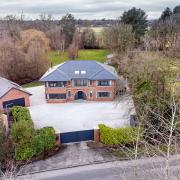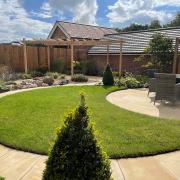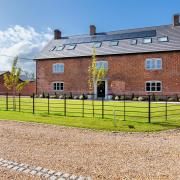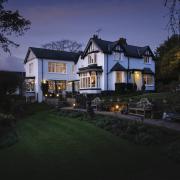Wistaston-based engineer Jag Virdie wanted to alter notions of domestic architecture, so he created a round, shiny, beautiful Conker.

Jag Virdie, who lives with his wife, Tania, and children, Connie and Sam in a beautiful Victorian home in Wistaston, started his career with an internship at Rolls Royce, where he was introduced to a cornerstone of Henry Royce’s ethos: ‘Take the best that exists and make it better. When it does not exist, design it.’ It is this statement that has driven his own approach to everything he does, whether that be work or play.
‘I started my career in automotive design and engineering with Rolls-Royce Bentley, had a brief period with Lotus before returning to Bentley and then set up my own freelance design business in 2010, Aesculapius Limited. I thought that as I was doing work for others, coming up with ideas, why don’t I try and design something unique for a wing system for a car, taking the aerospace experience and bringing it to automotive. I redesigned how a wing should work on a car, applied for five patents, showed them to Jaguar Landrover and they immediately said they wanted to buy them from me, so 2020 is the next generation of the F-Type and that’s when my wing is going to be on the back of that car.
‘When my children were younger, we built ourselves kayaks, as part of an engineering challenge with five friends, for a family trip. I learnt about wood through that, with both Connie and Sam. After that, we decided to build a treehouse. I didn’t want to build a traditional treehouse, it’s got to be something different, and I wanted a sphere, to hang like a conker.’
It was this that inspired Jag’s view on building design.

‘The mission for Conker Living is to change the way things are designed today, by disrupting the norm and challenging construction practices at their core. It all went back to my automotive work: how can I bring that same level of engineering from automotive and aerospace to building construction?
‘The Conker I have built here is just the start point of where we want to go. We’re looking at smaller ones and much larger ones that will be three bedrooms inside and even a full house, and all the foundation you require is the four legs, so you don’t need to disrupt the ground. Because of the shape of it, there’s no maintenance on the outside and you can even update it when you want by requesting new panels. It’s aerodynamic, doesn’t require any guttering and is the ultimate shape for heat efficiency.’
In today’s world, with our increased awareness of how much we affect our own lives when we unthinkingly upset the balance of nature – from flooding to drought and severely taxing natural resources – Jag’s design makes perfect sense. It can be built to operate completely off-grid, via solar panels and heat exchange systems, to be fully connected to an existing property, or be a hybrid version requiring occasional battery charging.
‘I have borrowed from a lot of big shoulders in creating this design,’ Jag says. ‘People who have come up with so much for the world, but no-one has ever tried to put it all together before: Bessemer, who created the process for making carbon steel - he worked to the principle that you take out everything and then only put back in what you need; Paxton, who designed and built Crystal Palace - he inspires me as he effectively pre-solved any potential problems by designing the tools needed for the build. Tania introduced me to the work of Barbara Hepworth – she not only designed the most beautiful sculptures, but designed the tools she’d need to make them.
‘Aerospace and automotive engineers have learnt how to integrate engineering excellence into understanding what the customer wants and needs and all I’m doing is trying to bring this to construction.’
The potential uses are myriad. Jag has already been approached by a family who want one for an elderly relative with Alzheimer’s; it would provide a safe space with which he can easily familiarise himself, keeping him close to his family while living with dementia.
This leads to bigger thinking: could a care home be created from a series of Conkers, each attaching to a central hub? Could two Conkers be linked, for a carer in one and an elderly or disabled person in another? Can they be dropped into challenging environments for use by scientists or as domestic homes? Are they suitable for use as high-end ‘glamping’ pods? Or permanent fixtures in areas where traditional housing simply isn’t feasible? Think steep mountainsides, boggy marshland or floodplains. The answer to all these questions, and many more, is yes.
The Conker can be fitted as an office space, a bedroom with wetroom, a scientist’s lab, a play area, a sitting room…pretty much anything you want. You can link two or more, upsize it or downsize it (a dangling treehouse, anybody?), you can situate it in urban, suburban, rural or extreme enviroments…the possibilities are positively kaleidoscopic. And Jag’s target market is immensely wide and getting wider every day, as new ideas occur.
‘It’s taken me two-and-a-half years to work out and every single thing is designed and manufactured in the UK: Wales, Lancashire and Yorkshire, before being assembled in Chelford. ‘
It’s a stunning piece of design, not just in its visual form, but in what it actually delivers, both to the user and for the environment. I can’t wait to see how this story develops.



























